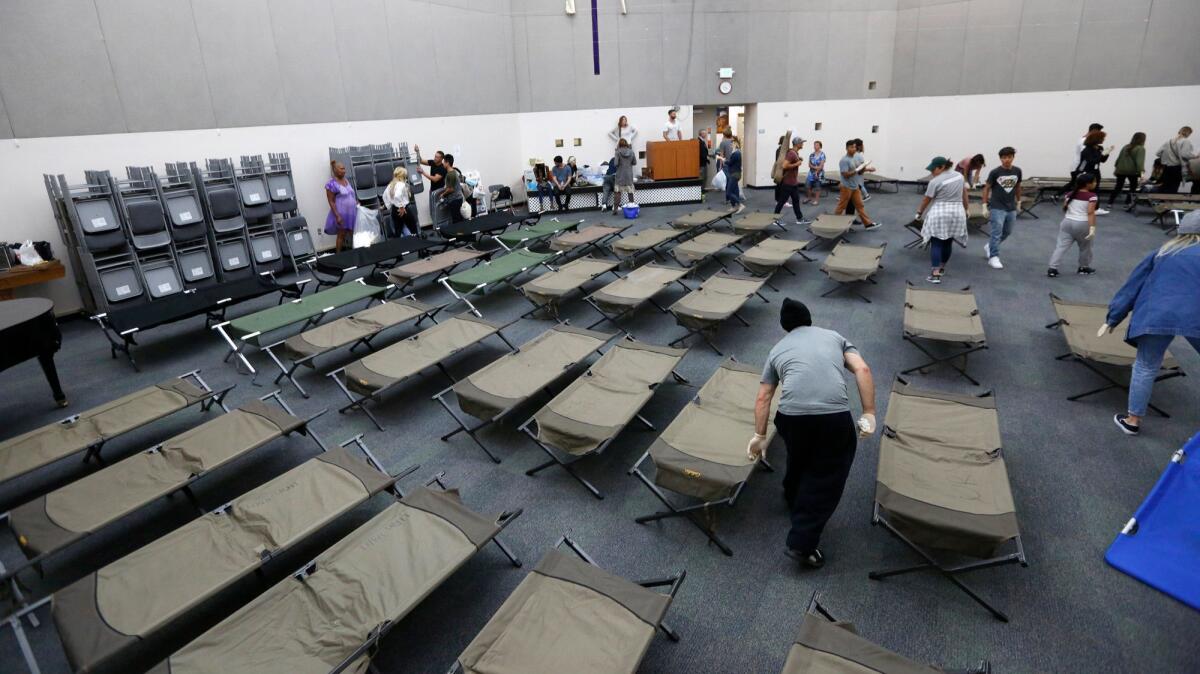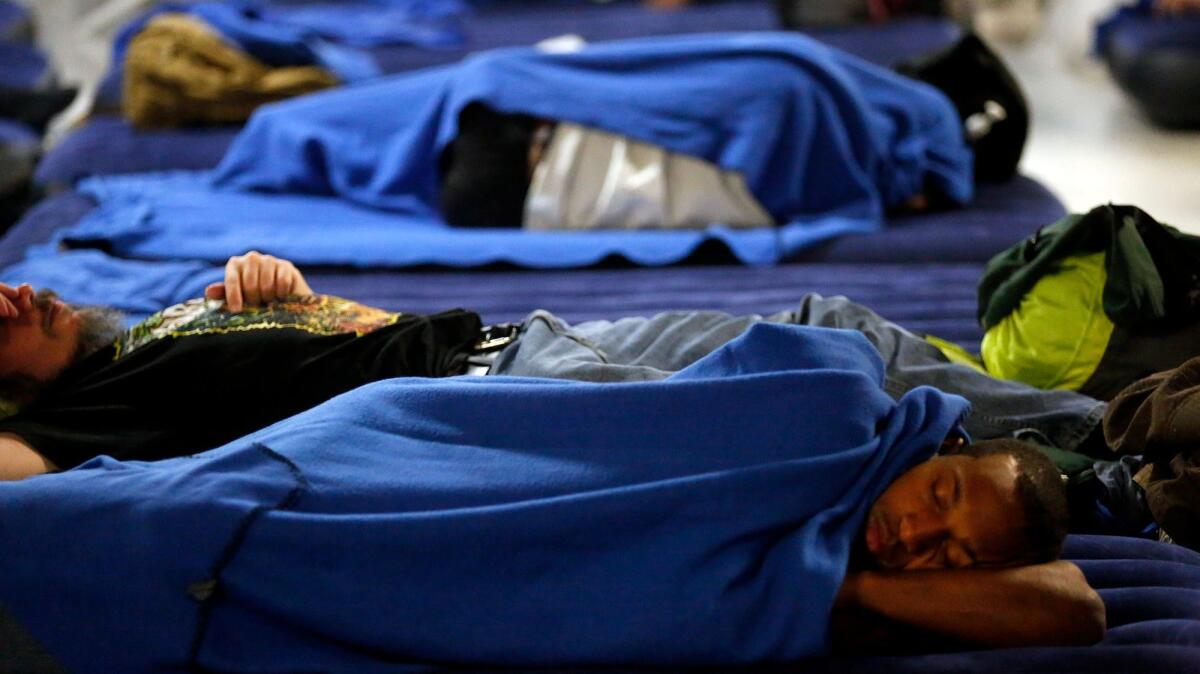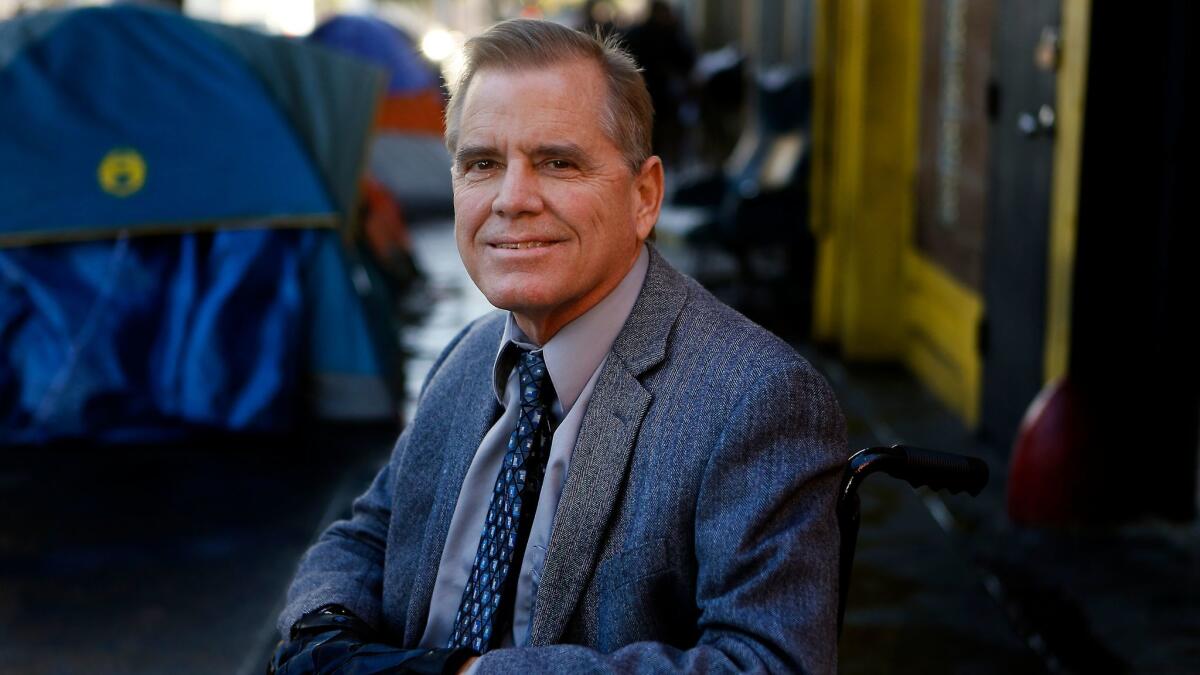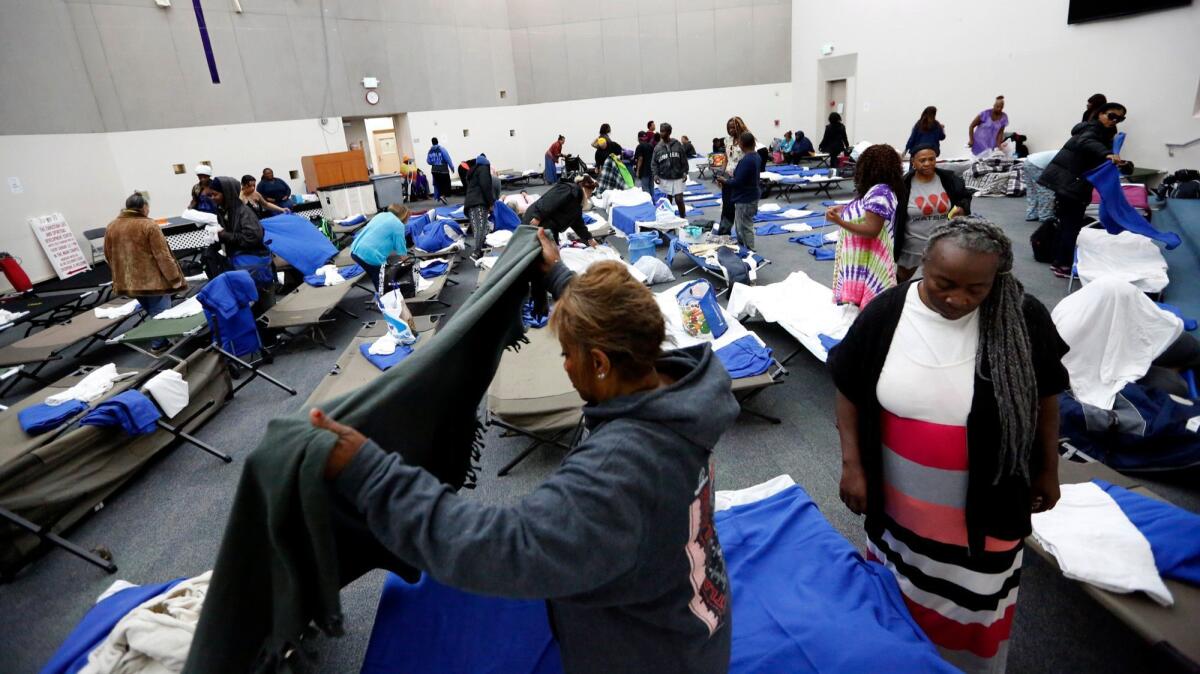L.A. County now has 58,000 homeless people. So why are there thousands fewer shelter beds than in 2009?

- Share via
“Live from skid row, it’s Tuesday night!” Pastor Dan shouted, beginning two hours of Christian music and prayer for worshipers arrayed on metal chairs in the spacious, white-walled chapel at the Union Rescue Mission.
Once the playful service ended, worshipers folded and stacked their chairs and began to unfurl cots. There weren’t enough for everyone.
“Blankets and sheets on the floor,” the resident concierge at the chapel doors told latecomers who had waited outside for admission. “Blankets and sheets on the floor.”
By lights out, 1,300 people were bedded in the five-story building in the heart of skid row, women overflowing into the chapel and men on mattresses on the floor of the day room.
The crush of bodies at the Union Rescue Mission is a snapshot of the deficiencies in L.A.’s shelter network.

The county has one of the nation’s largest homeless populations, but its ratio of shelter beds to homeless people is among the nation’s lowest. There is no overarching shelter policy and no budgeting process to fund more shelters when homelessness increases. With rare exceptions, public agencies in Los Angeles do not build and operate shelters.
Instead, contractors operate facilities that range from a few cots in a church storage room to hundreds of bunks lined end to end in converted industrial buildings. They compete for a pot of local and federal money that has been shrinking in recent years.
“We do not have a standard for temporary subsistence housing,” said City Councilman Marqueece Harris-Dawson, chairman of the council’s Homelessness and Poverty Committee. “I don't think we have ever admitted that shelters are a permanent part of our society even though they've been here for as long as history has recorded.”
Even as L.A.’s homeless population has surged in recent years, spurring voters to approve two tax measures, officials have de-emphasized shelters in favor of building new permanent housing and providing rental subsidies for market-rate housing.
Many L.A. officials say shelters do little to alleviate homelessness, arguing that they cost about the same as permanent housing and provide only brief respites from the streets.
So they have worked to reshape the shelter as a staging area where people stay briefly on the way to permanent housing. New funds have been directed toward bulking up housing and case management services at existing shelters rather than adding new beds.
As a result, there is now only one shelter bed available for every four homeless people — one of the nation’s lowest shelter bed rates, according to a Times analysis of federal housing data.
By comparison, there are about three shelter beds for every four homeless people in the nation’s 402 homeless services areas, the data showed.

Many millions to spend, but what’s the best approach?
County voters in March approved Measure H, a sales tax increase that will bring in an estimated $355 million annually starting this fall.
A budget adopted in June by the county Board of Supervisors included $209 million over three years to improve the county’s shelter system.
But there are radically different visions of how that money should be spent.
For Andy Bales, chief executive of the Union Rescue Mission, nothing short of a crash program to get every homeless person off the streets is morally justifiable.
“I am haunted right now about the people who are on the streets,” Bales said. “I'm haunted by the families in South L.A. with kids wandering around with no place to stay.”
Bales and others who face homelessness daily want the city to adopt a New York model, with shelters for every person counted.
Local officials have far more limited plans.
“The simplistic response of saying, ‘Why don’t we put 47,000 people into shelter?’ — we’re not going to do that,” said Phil Ansell, head of the Los Angeles County Homeless Initiative, referring to the total from the 2016 count. “We’re not going to have anywhere near that kind of increase in shelter.”
I'm haunted by the families in South L.A. with kids wandering around with no place to stay.
— Andy Bales, chief executive of the Union Rescue Mission
The plan adopted by supervisors in June allocates enough money for 2,175 new units for individuals and families over three years.
The budget projects that more than 11,500 additional people would receive shelter annually as a result, based on the assumption that the beds would turn over on average every three months as clients move on to permanent housing.
Even if that optimistic goal is met, it would make only a small dent in the county’s street population.
But officials project a further net reduction in shelter beds. A 2016 analysis by the homeless authority said adding 2,279 shelter beds would erase the current shortage. But it also foresaw the elimination of nearly 3,000 beds of transitional housing, which provides for stays of up to two years.

Proposal: Put up 100 tents, housing 200 people each
None of those efforts strikes Bales, as sufficient.
“We really should treat this catastrophe for what it is,” he said, “A catastrophe.”
His vision for bridging the shelter gap calls for tents around the city — big tents. The first would be erected on the mission’s surface parking lot on San Julian Street.
“We’re going to house 200 single women every night,” Bales said, adding that he aims to recruit other churches to put up tents on their parking lots.

Many types of shelter
- The 17,801 Los Angeles County shelter beds in the January count were not all alike.
- 1,708 seasonal beds were open in December through March.
- Nearly half, 7,108, were transitional beds with stays of up to two years.
- 4,050 were funded by the Department of Public Social Services providing 16-day stays for welfare and general relief recipients with a possible 14-day extension.
- Only 4,953 beds were for crisis intervention.
Twitter: @LATdoug
ALSO
L.A. Unified students toss out $100,000 in food a day. A new state law could donate it to food banks
ICE arrests hundreds of immigrants in 'sanctuary cities' around the nation, California
Complaint alleges harm to pregnant women in immigration detention centers
Sign up for Essential California
The most important California stories and recommendations in your inbox every morning.
You may occasionally receive promotional content from the Los Angeles Times.








